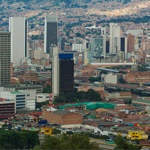The "Murder Capital" Puts Down its Guns
Fifteen years ago Colombia was almost a failed state. Leftist revolutionaries controlled big tracts of jungle. There were battles with the army and paramilitaries. Drug cartels ran many of the big cities. It was one of the last places on earth you would think of investing in real estate.
However, these days that’s exactly what I’m doing. And here’s why…
Even before April of this year, when TIME magazine wrote about “the Colombian comeback,” I visited the country to see for myself what was going on.
I spent time in Medellín — one-time “murder capital of the world,” now a totally transformed city. I visited the country’s Caribbean coast. And I saw for myself wealthy Colombians enjoying their new vacation pads and relaxing on sandy beaches.
Colombia’s middle class is on the upswing. The rich are getting even richer. And we can profit by buying the type of apartment these people want to live in. Prices today reflect Colombia’s past. Not her present or future potential. You can net an 8% yield from a rental here. And you are buying so cheap that, as this middle class grows, values will increase. You are also getting diversification from your dollar; real estate here sells in Colombian pesos.
This “comeback” hasn’t happened overnight. Nor is Colombia rid of the security issues that ripped the economy apart. If you are trying to pipe oil hundreds of miles through the jungle or prospect for gold in remote areas surrounded by armed gangs or guerrillas, the issues are clear. Powerful criminal elements have emerged that are bold and brazen.
But the income of the average Colombian has doubled in less than a decade. Shiny new boutiques and restaurants line Medellín’s Golden Mile.

Roads are tightly packed with cars, many of them brand-new. Approximately two out every five Colombians is under 20. And they are full of optimism as they congregate in open squares and plazas. Many of their older brothers and cousins who left in the 1990s are returning.
Foreign companies — Canadian resource and European manufacturing — are establishing themselves. Expat hangouts are packed with Canadian and European resource contractors.
On Wall Street they call Colombia “the next Brazil” with good cause. Colombia has gold, oil, and hydroelectric power. It grows coffee and has plentiful forests. Debt levels are low. The population is young.
And after two decades of liberalization the Colombian government is one of the most forward- and outward-looking in the region. “We don’t expropriate,” President Santos told a group of Spanish businessmen who arrived shortly after Argentina’s President Kirchner took control of oil company YPF. The Colombians have closed a free-trade deal with the US and wealthy Venezuelans are now flooding into the country, bringing oil expertise. Growth is running at 6%. Inflation is low at 3.4%.
Colombians and international investors have good cause to be confident. It’s just like what I saw in northeast Brazil in 2008. (See below.)
An ambitious, $100-billion infrastructure plan is in the works (and desperately needed) for the next decade. Roads, airports…even an $8-billion, Chinese-funded railway that will compete with the Panama Canal. The Chinese want to get Colombian coal out without having to incur hefty Panamanian tolls. A government program calls for 200,000 new houses. And there is a focus on initiatives to improve social mobility.
How exactly do you play this upward swing? By buying the type of apartment the new upper middle class wants to live in. The best opportunity is in Medellín. The notorious Medellín cartel is finished — history. (You can now take a guided “Pablo Escobar” tour.)
In the city’s upscale areas of El Poblado and along its Golden Mile, you can buy a well-built, 1,000-square-foot condo in an older building for as little as $100,000. This area of Medellín is the place to be and to invest.
There’s a real café culture here. Like what you’ll find in a leafy European city. But here you get to sip your coffee or dine outside year-round. Scorching summer heat or cool winters won’t cramp your style, seeing as the perfect weather (Medellín sits at 5,000 feet) only varies by one degree all year. You’ll find great restaurants, trendy bars, and fancy boutiques.
Minutes away from El Poblado, the Golden Mile is an area of banks, offices, boutiques, and outdoor eateries that buzzes with traffic and commerce. On the weekends the nightlife is around here and in the Zona Rosa in El Poblado.
Sizes are quoted in square meters. You can multiply by 10 for a quick-and-dirty calculation of what that converts to in square feet. Prices on a per-square-meter basis are generally higher here for smaller units. Interestingly, large penthouse units with outside space can be found at the lower range of prices per square meter. Views just don’t seem that important to locals.
Pre-construction condos sell for $2,000 per square meter and above. This is a crazy anomaly. Pre-construction is dramatically overpriced compared to older apartments. Figure $1,500 to $1,600 per square meter for a shiny new condo in a high-end building that was delivered within the past couple of years.
You’ll find that short-term rentals aren’t permitted in the nicer, owner-occupied buildings. It’s illegal to rent your unit short-term (less than one month) if 70% of owners in the building haven’t agreed to this. But these are still the best buildings in which to buy. The best-maintained and the quietest. The type of building in which the new upper middle class will want to buy or rent. You could net a yield of 8% by renting to a visiting executive from abroad for a few months at a time. There’s a constant flow, as well as agents who specialize in this market.
Sign a year-long contract with a local and your yield will be a bit less. Multinationals like Hewlett-Packard are making Medellín their home. Domestic Medellín-based multinationals are strong in cement, financial services, and food products.
With Colombia staying the course to normalization and beyond, prices are set to rise strongly over the next five to 10 years. And each year while you wait you could bag an 8% yield. Confidence is everywhere.
When I visited Santa Marta and neighboring resort towns on the Caribbean coast, condo buildings were shooting up from beachfront plots. They were selling fast, and long before buildings were finished.
Not on the cheap. A decent condo with a view could set you back $300,000. The buyers were Colombians living in Medellín and Bogotá. And Colombians living in the US and Europe. Five years ago they would have bought a condo in Miami or Panama. Now they have the confidence and comfort to put themselves and their money in their home country.
Don’t expect Colombia’s progress to be without disturbance. But Colombia is on the up. The people are enjoying a peace dividend. They won’t hand that back easily. The fighters and revolutionaries are old and tired. If Colombia comes close to reaching its potential, it will live up to its label as “the next Brazil,” where real estate values rose by up to 20%…year after year.
Regards,



Comments: